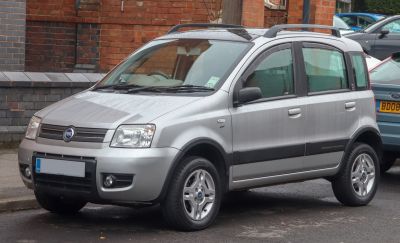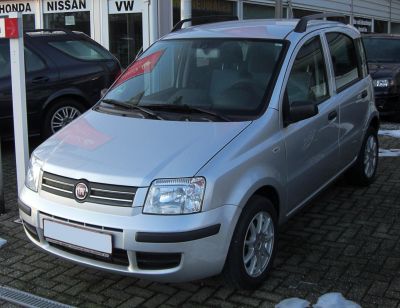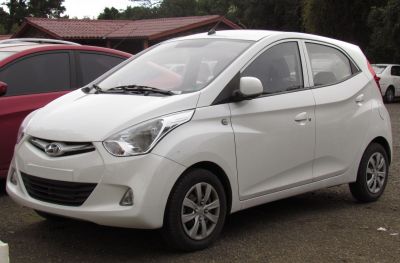 2008 Hyundai i10 I Dimensions, Size & Specs
2008 Hyundai i10 I Dimensions, Size & SpecsMeasurements of the 2008 Hyundai i10 I, engineered for optimal performance and comfort
| Dimensions | |
|---|---|
| Length: | 3565 mm140.4 in11.7 ft |
| Width: | 1595 mm62.8 in5.2 ft |
| Height: | 1540 mm60.6 in5.1 ft |
| Trunk Capacity: | 225 liter7.9 cu ft |
| Trunk Capacity (Max): | 910 liter32.1 cu ft |
| Weight Specifications | |
| Curb Weight: | 1000-1040 kg2205-2293 lbs |
| Maximal permitted Weight: | 1325-1520 kg2921-3351 lbs |
| Tire Specifications | |
| Rims Size: | 14-inch rims:
|
| Tire Sizes: |
|
The Hyundai i10 I, produced from 2008 to 2010, is a compact hatchback designed specifically for urban mobility and efficiency. With an overall length of 3565 mm (140.4 inches), a width of 1595 mm (62.8 inches), and a height of 1540 mm (60.6 inches), this model offers a practical footprint that fits easily into city parking spaces and tight traffic conditions. Weighing between 1000 and 1040 kilograms (2205 to 2293 pounds), the i10 I balances lightweight construction with stability, contributing to fuel efficiency and nimble handling. The maximum permitted weight ranges from 1325 to 1520 kilograms (2922 to 3351 pounds), accommodating passengers and cargo comfortably within safe limits. The luggage capacity measures 225 liters (7.9 cubic feet) with rear seats up, ideal for everyday grocery runs or small luggage. When the rear seats are folded down, the capacity expands significantly to 910 liters (32.1 cubic feet), offering enhanced versatility for carrying larger or bulkier items. This first-generation Hyundai i10 sits on 5J x 14 rims and supports tire sizes ranging from 155/70 R13 to larger options like 165/60 R14 and 175/60 R14, providing flexibility depending on road conditions or trim levels. Overall, the Hyundai i10 I is a practical and efficient small hatchback that combines compact dimensions with ample interior space, making it a favorable option for drivers seeking an economical and easy-to-drive city car during its production years.
Discover the standout features that make the 2008 Hyundai i10 I a leader in its class
Have a question? Please check our knowledgebase first.
The Hyundai i10 I, produced from 2008 to 2010, has a compact exterior well-suited for urban driving. It measures 3565 mm (140.2 inches) in length, which helps with maneuverability in tight city spaces. The width is 1595 mm (62.8 inches), making it narrow enough for easy parking and lane changes, while its height is 1540 mm (60.6 inches), providing a comfortable headroom inside. These dimensions contribute to its hatchback profile and practical footprint.
The curb weight of the Hyundai i10 I ranges from 1000 kg to 1040 kg (2205 to 2293 lbs), depending on specific trims and equipment levels. This relatively light weight contributes to its fuel efficiency and agile handling. The maximum weight, also known as gross vehicle weight rating (GVWR), varies between 1325 kg and 1520 kg (2922 to 3351 lbs), indicating the total load capacity including passengers and cargo. These figures show the i10 I is lightweight but adequately built to carry a small family with some luggage.
The Hyundai i10 I offers a practical luggage space of 225 liters (7.94 cubic feet) with the rear seats in the upright position, suitable for daily groceries or small suitcases. When the rear seats are folded down, this capacity expands significantly up to 910 liters (32.13 cubic feet), enabling transport of larger items or bulkier cargo. This flexibility makes the i10 I exceptionally functional for a city hatchback, balancing passenger comfort with cargo versatility.
The Hyundai i10 I is equipped with rims sized 5J x 14 inches, which supports tire options like 155/70 R13, 165/60 R14, and 175/60 R14. These tire sizes provide a balance between ride comfort, road grip, and fuel efficiency. The availability of multiple tire sizes allows owners some customization according to driving conditions or preferences for better handling or softer ride quality.
Yes, the Hyundai i10 I fits comfortably inside a standard garage. With an exterior length of 3565 mm (140.2 inches) and a width of 1595 mm (62.8 inches), it is smaller than many compact cars, making it easy to park indoors. Standard single-car garages typically have an internal clearance of around 6 meters by 3 meters (approximately 19.7 feet by 9.8 feet), providing ample space for the i10 I plus additional room for opening doors and storage.
Since the Hyundai i10 I introduced in 2008 was the first generation i10 model, there is no predecessor directly named i10 to compare it to. However, it replaced the Hyundai Atos/Santro in many markets as Hyundai's small city car offering. Compared to the Atos, the i10 I is slightly larger and more modern in design, offering improved interior space, comfort, and safety features. Its dimensions reflect a move towards more refined urban transportation, larger than the typically tiny city cars that came before.
The Hyundai i10 I sits comfortably in the compact city car segment alongside competitors like the Suzuki Alto, Kia Picanto, and Toyota Aygo. Its length of 3565 mm (140.2 inches) and width of 1595 mm (62.8 inches) makes it comparable to or slightly larger than some rivals, providing a bit more interior room without sacrificing maneuverability. Its luggage capacity also stacks up favorably, especially with rear seats folded. The i10 I's balance of size, weight, and interior space made it a popular choice for city drivers seeking practicality plus modest comfort.
Despite its compact exterior, the Hyundai i10 I is designed to maximize interior space for up to five passengers. The relatively tall height of 1540 mm (60.6 inches) contributes to good headroom, making the cabin feel more spacious than many small hatchbacks. While rear legroom is modest due to the car's city-focused size, front occupants benefit from a comfortable seating position and sufficient shoulder room courtesy of the car’s 1595 mm (62.8 inches) width. Overall, the interior layout prioritizes efficient use of space for comfort and practicality.
With a curb weight between 1000 kg and 1040 kg (2205 to 2293 lbs), the Hyundai i10 I is light enough to enhance fuel economy and provide nimble handling characteristics in urban environments. The compact size and relatively low mass reduce fuel consumption, making it an economical choice for city commuting. Additionally, the car's small footprint and light weight improve maneuverability and responsiveness, allowing for easier parking and navigating tight spaces, which is critical for a city hatchback.
The Hyundai i10 I comes with 5J x 14-inch rims commonly paired with tires sized 155/70 R13, 165/60 R14, or 175/60 R14. Of these, the 165/60 R14 and 175/60 R14 tire options generally provide a good balance between ride comfort and grip due to their wider footprint and larger rim diameter compared to the 155/70 R13. They help in improving road handling and stability, especially on uneven surfaces, while maintaining acceptable levels of comfort and fuel efficiency for daily driving.
Discover similar sized cars.

| Production: | 2004-2012 |
|---|---|
| Model Year: | 2004 |
| Length: | 3538-3574 mm139.3-140.7 in |
| Width: | 1578-1605 mm62.1-63.2 in |
| Height: | 1540-1632 mm60.6-64.3 in |

| Production: | 2003-2012 |
|---|---|
| Model Year: | 2003 |
| Length: | 3538-3578 mm139.3-140.9 in |
| Width: | 1578-1606 mm62.1-63.2 in |
| Height: | 1540-1614 mm60.6-63.5 in |

| Production: | 2008-2010 |
|---|---|
| Model Year: | 2008 |
| Length: | 3548 mm139.7 in |
| Width: | 1580 mm62.2 in |
| Height: | 1544 mm60.8 in |

| Production: | 2011-2019 |
|---|---|
| Model Year: | 2012 |
| Length: | 3495 mm137.6 in |
| Width: | 1550 mm61.0 in |
| Height: | 1500 mm59.1 in |

| Production: | 2024-present |
|---|---|
| Model Year: | 2020 |
| Length: | 3620 mm142.5 in |
| Width: | 1652 mm65.0 in |
| Height: | 1577-1605 mm62.1-63.2 in |
